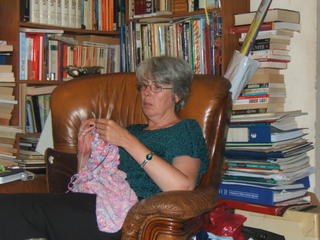How to design a simple Jacket
(This is my copyright, but you are welcome to use it. Just don't reproduce it without checking with me first - OK?)
Designing a simple jacket, or what to do if you can't find a pattern
There are several good books around that may be of help to you - eg. Maggie Righetti, "Pattern design in Plain English", and several other writers (examples Sally Melville, Montse Stanley, Debbie Stoller)include at least a small section on pattern drafting/adaptation in their books. Ann Budd's book "The knitters handy book of sweater patterns" is very good, as it doesn't rely on using any particular yarn and covers multiple sizes and basic shapes (drop sleeves, semi drop sleeves, set-in sleeves, raglan, etc) and how to adapt them, and since it uses exact numbers of stitches to the inch, might be particularly useful for the tension I was given (which works out at a nice 3 stitches and 5 rows to the square inch).
If you're feeling a bit brave, why not try writing your own pattern? - the simplest jacket is 5 pieces, a back, 2 fronts and 2 sleeves, and could be made very simply from rectangles - for example, off the top of my head (and with only a little help from my trusty calculator), here's a pattern for an average size (will fit up to a UK size 14-16) with drop sleeves, edge to edge fronts, with simple revers neckline and collar. Finished measurements will be 40" circumference, and 24" back length
Using tension as given above (if your yarn gives a different tension, you'll have to work it out yourself, but at least the methodology below should help you):
Back
cast on 60 stitches (that's half the finished circumference 20 inches x 3 stitches). Work about 6 - 8 rows in Garter stitch on a smaller needle size (say 3.5 - 4mm) - this gives you about an inch in length - to prevent curling, then change to the larger needles that give you the tension you quoted, and work in stocking stitch till you get to 24 inches (that will be a further 23 inches x 5 rows, ie 115 rows,
but call it 116 rows to end with a purl row. Cast off.
2 Fronts (both alike at this stage)
Cast on 27 stitches on smaller needles (that's 9 inches x 3 stitches - the other inch will go in the front band). Work Garter Stitch as for back, and the same length in stocking stitch as for the back then cast off.
2 sleeves (both alike)
Cast on 30 stitches (gives a wrist measure of 10 inches - you can adjust this if you like a looser wrist) on smaller needles. Work g.st as before, then switch to larger needles for stocking stitch. You are aiming for a sleeve top of about 18 inches across (which is 18 x 3 sts = 54 stitches), so you are going to need to do some increases to get there, that's an additional 24 stitches which will be increased in 12 pairs at intervals as you knit, say about every inch. So work stocking stitch for 6 rows, ending purl row. Next row inc 1 at each end of the row, work another 5 rows. Repeat these 6 rows 12 times in all - that will give you a length of approx 15.5 inches (1 inch for the g. st, and 72 rows in st.st.). Knit straight until sleeve measures 18 inches (assuming an average arm length). Cast off.
Finishing:
Block pieces if necessary. On each of the fronts you need to designate one side as the side seam, and the other side will be the opening (and these will be mirror images of each other). You need to pick up stitches for a g. stitch border. Using smaller needles and right side facing, pick up 3 stitches for every 4 rows in stocking stitch, and 1 stitch for each g.st 'ridge', so you'll pick up about 90 stitches in all. Work 6-8 rows in garter stitch and cast off.
Join the shoulder seams, these will be 6 inches in length, counting from the edge that will become the side and sleeve seams side, the middle 8 inches of the back, and 4 inches from each front will become the neck opening.
Measure down from the shoulder seam 9 inches on back and front and mark this. Attach the sleeve top between the front and back markers. Join the sleeve and side seams. (Nearly there!)
Finally! - You need to finish off the neck edge in some way, a few rows of garter stitch would do, or if you work more than a few then you would get a little collar. (Note that I have not made the front neckline lower than the back, this is because I want to encourage the jacket fronts and collar to make a simple revers neckline).
With right sides facing and smaller needles, pick up 1 stitch for each g.stitch ridge from the front edge, then 1 stitch for every stitch in st.st. (that'll be 9 stitches from each front, and 24 from the back, ie about 48 - 50 stitches altogether. If you work 4 - 6 rows, you get a neat edge - if you want a collar, work the 4 - 6 rows first, and then change to larger needles, and work another 12 - 16 rows in g.st. Cast off.
Admire! Wear! (Award yourself a large bar of chocolate if you like!)
This jacket is about as simple as it gets, in terms of shape. Think of it as a starting point ... From here, the sky's the limit - you can shape shoulders, armholes, necklines, sleeves ... and all you need is a calculator, a set of measurements, and a tension swatch!

















0 Comments:
Post a Comment
<< Home